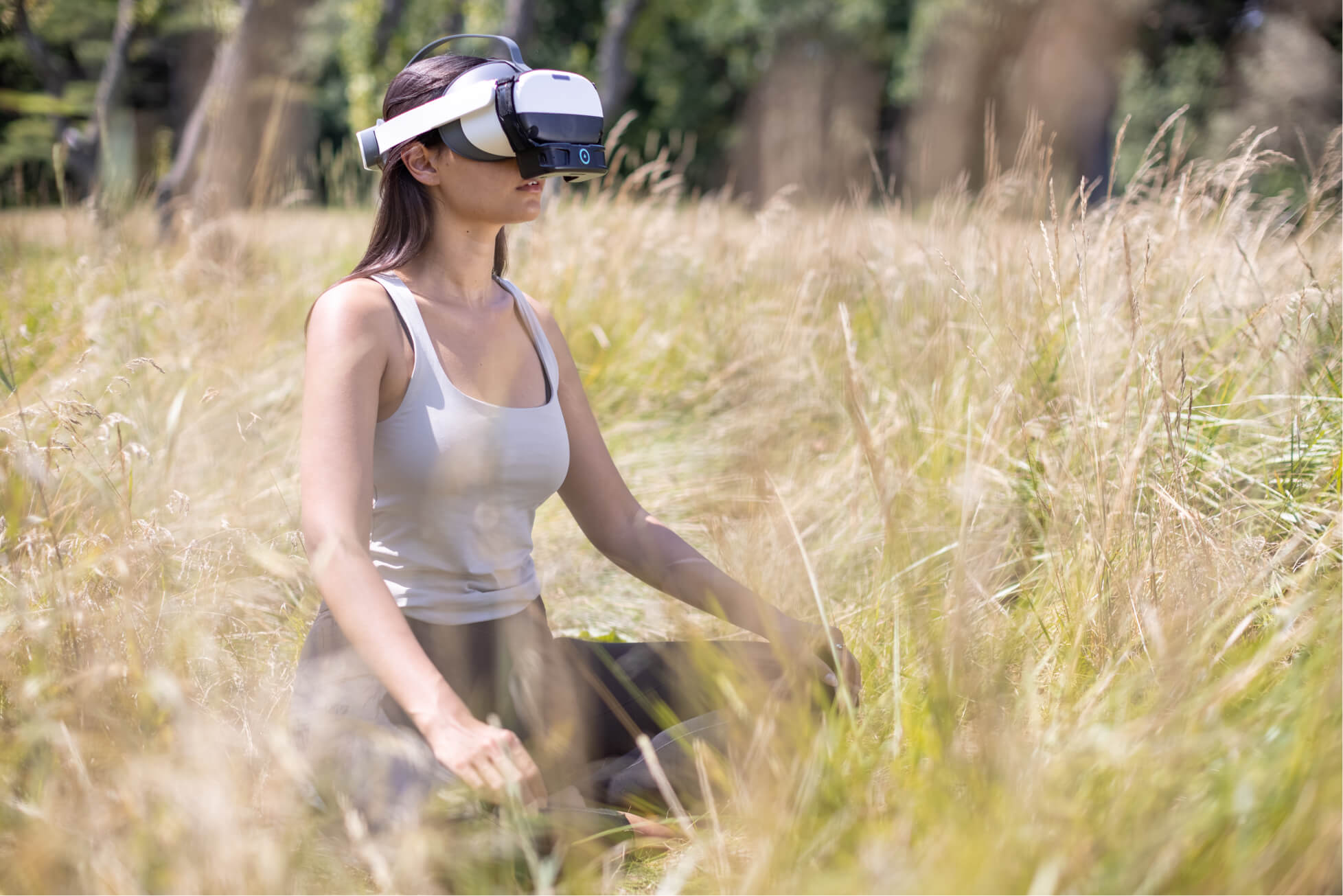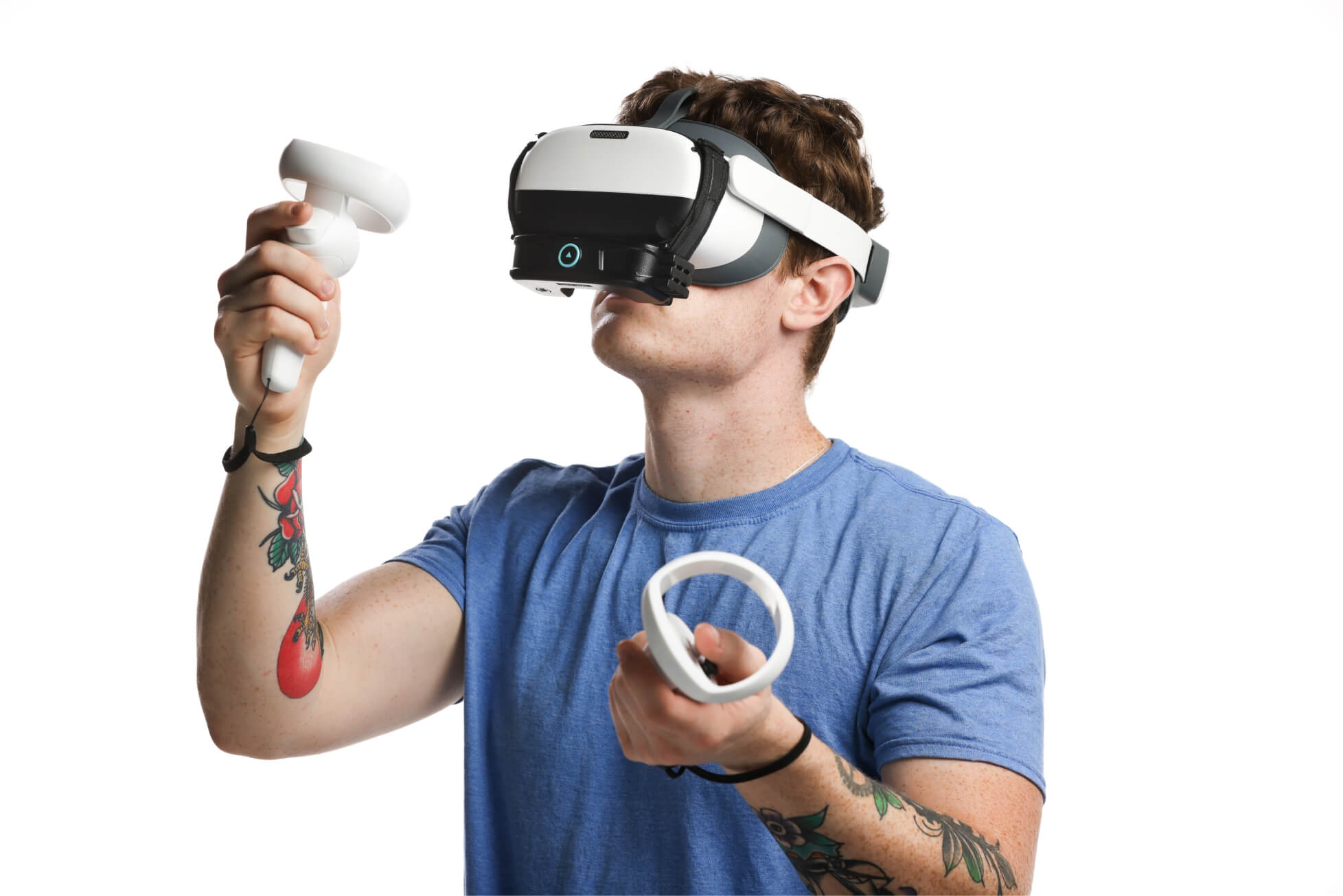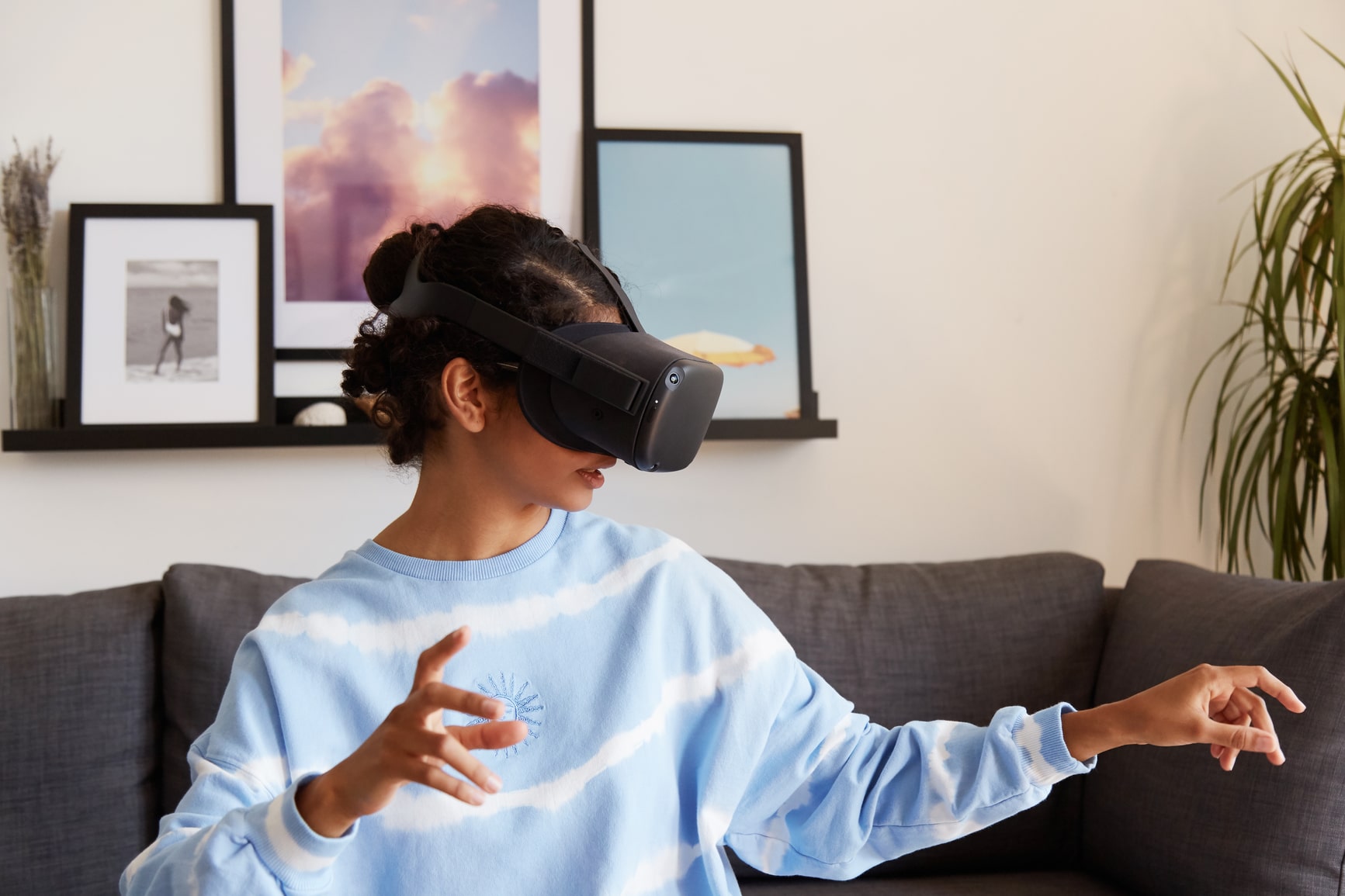Between the hectic pace of modern life and mounting collective mental health concerns, mindfulness may offer a salve for many of society’s ills.
At its best, it promises a much-needed path toward a deeper sense of fulfillment in and acceptance of an increasingly complex, head-spinning world.
These days, mindfulness is for busy moms, productivity-driven CEOs, ambitious entrepreneurs, even stressed-out kids. In short, mindfulness is for everyone, and it’s finding its way into the fabric of what we do.
As it does so, it’s being interwoven with another ever-present staple of modern life: technology.
The Marriage of Mindfulness and Tech
Not surprisingly, meditation apps have soared in popularity. In 2015, the top 10 meditation apps generated $8 million in revenue. By 2019, that number had grown to $195 million, according to the market research site SensorTower.com.
Calm, a meditation and sleep app, was the second most popular health and fitness app in the Google Play Store for the United States, with approximately 345,000 downloads in 2021. (Planet Fitness Workouts was number one.)
Similarly, searches for “fitness apps” increased by 40 percent between 2019 and 2021, according to Google data.
Along with the growth in apps, 1 in 5 Americans report using wearable technology, and a 2021 study noted that smart technologies and wearable devices show promise for earlier detection and symptom management of mental health conditions.
With the parallel mushrooming of both mindfulness and tech, it was only a matter of time before the two joined forces to improve our well-being.
Mindfulness: The Why and the How
Mindfulness isn’t always easy, yet more and more people are adopting it.
A 2020 study noted that the reasons people meditate are diverse.
For beginners, meditation is often used as a way to reduce negative aspects of life, like stress and anxiety. They’re looking for solutions to their problems. On the other hand, experienced meditators use it to enrich their lives.
That said, if you’ve ever meditated before, you’ll likely agree that it’s not the easiest thing to do. While you may come away from a meditation session feeling calm and at ease, actually getting to it on a regular schedule can prove challenging.
And once you get there, it’s not always a walk in the park.
Meditation can test your patience and put a spotlight on your mental chatter.
One of the main goals behind emerging technology is to make meditation more appealing, digestible, and practical in a world of seemingly endless demands on your time and attention.
What makes a meditation practice effective (according to a 2020 study of novice meditators)?
According to a 2020 study of novice meditators, the effectiveness of a meditation practice is dependent on five factors:
- frequency of practice
- duration of practice
- adherence to the instructions of practice
- understanding the “why” of practice
- enjoying the practice
One of the main goals behind emerging technology is to make meditation more appealing, digestible, and practical in a world of seemingly endless demands on your time and attention.
According to Sam Zand, DO, Chief medical officer of the psychedelic online therapy provider Better U, tech can help make mindfulness make sense to a screen-obsessed, data-driven society.
The question is, does it do the job? Zand thinks so. He says that tech-assisted techniques are “just as effective” as regular meditation and mindfulness practices.
“Proper brain health involves daily effort, and the more we can practice healthy mental exercises at home, the better,” Zand says.
In addition to making mindfulness more accessible for the average person, Jon Fellows, DO of the Michigan Institute for Neurological Disorders (MIND) notes that mindful tech may hold promise for neurological conditions, including:
- multiple sclerosis
- epilepsy
- migraine
- dementia
- Parkinson’s disease
- depression
- anxiety
“Almost all chronic neurological diseases can benefit from technology that embraces mindfulness,” says Fellows.
Let’s take a look at the best and brightest of the mindful tech world and learn how these innovative products can make mindfulness an accessible part of daily life.
Neurolign Fit

- Price: $149 for the device, $89 annually or $9.99 monthly for membership
- Who it’s for: Anyone who wants to understand how their brain is performing and how to improve it
- What you need: Compatible with iPhone 11 and up
First up, meet the NeurolignFit. This handy little device attaches to your phone and measures your eye movements to give you insights about your brain performance.
It’s designed with the same technology that brings medical-grade assessment tools to doctors, neurologists, physical therapists, chiropractors, and other health professionals, only this version is meant specifically for personal use.
"The eyes are the window to the brain. Most wearables measure the physical. It’s not about the brain or the mind."
Prateek “Teek” Dwivedi
Chief development officer at Neurolign Technologies, Inc.
How NeurolignFit works
The patented eye-tracking technology of the NeurolignFit pairs with a personalized brain training program on your smartphone so you can easily train your brain and track your progress without bulky equipment or hassle.
“The eyes are the window to the brain,” says Prateek “Teek” Dwivedi, Chief development officer at Neurolign Technologies, Inc. “Most wearables measure the physical. It’s not about the brain or the mind.”
Dwivedi points out that the NeurolignFit system offers several more data points than the average fitness tracker using simple electrode technology.
In short, the NeurolignFit delivers a snapshot of brain activity.
“When we talk about mindfulness and meditation, we start with measuring the brain,” says Dwivedi. “What’s actually happening?”
According to a 2018 study, a clinical Neurolign Technologies device that, like the NeurolignFit, runs tests on eye, balance, hearing, and reaction time, was found to be effective in diagnosing and forecasting effects of traumatic brain injury.
Simply put, the metrics measured by Neurolign devices can help determine how well the brain is functioning.
In a clinical setting, it can help professionals identify and treat neurological disorders. At home, it can help you hone your cognitive functioning with exercises specific to your needs.
How to use it
You’ll begin with a 15-minute assessment to take a baseline measurement of three key areas of your brain function:
- Mental sharpness: the ability to respond quickly and accurately to new information
- Focus: the ability to filter distractions and stay on task
- Movement: balance, hand-eye coordination, and reaction time
"We treat the brain almost like a muscle. You just keep doing reps and sets over and over again until your brain gets better at it."
Once your scores are established, the system delivers customized training programs. The subscription component means there are always new training exercises, games, and challenges to keep you interested and engaged.
Dwivedi suggests thinking about the NeurolignFit system like an exercise program, only that it takes no special skill and requires only 3 minutes per day.
“We treat the brain almost like a muscle,” he says. “You just keep doing reps and sets over and over again until your brain gets better at it.”

Why we chose it
What makes the NeurolignFit so innovative? It brings tech that was previously only available in a clinical setting into the home. Plus, it doesn’t require a big time commitment or learning curve.
"You have to have good brain health so you can practice mindfulness. People who are struggling are often struggling because their overall brain health isn’t there yet."
While it’s not specifically marketed as a mindfulness device, the three areas of brain function it targets are involved in the kinds of skills needed for an effective mindfulness practice.
“You have to have good brain health so you can practice mindfulness,” Dwivedi says. “People who are struggling are often struggling because their overall brain health isn’t there yet.”
If you get distracted or feel antsy when you try to practice meditation, the NeurolignFit may help you train your mind to get to a point where it isn’t so restless.
In other words, the program can help you lay the foundation for a mindfulness practice that’s truly fruitful, rather than frustrating or discouraging.
NeoRhythm

- Price: $299 for the device No additional costs
- Who it’s for: Anyone interested in increased focus, less stress, better sleep, or reduced pain
- What you need: Android or iPhone
Move over, meditation headband. The NeoRhythm is making its debut.
Created by OmniPEMF, the NeoRhythm is a transcranial pulsed electromagnetic field (T-PEMF) device. Magnets embedded in the device passively emit frequencies to stimulate electrical activity in the brain, encouraging sleep, relaxation, focus, deep meditation, even pain relief.
You can also opt in to the OmniPEMF online community where other NeoRhythm users share experiences, learnings, and updates on the latest research in PEMF technology.

OmniPEMF
How NeoRhythm works
NeoRhythm features a headband containing inverted coils that produce harmless electromagnetic fields, which emit waves in patterns that your mind and body seek to imitate, according to OmniPEMF.
This T-PEMF technology is also known as repetitive transcranial magnetic stimulation (rTMS).
According to 2019 research, this kind of treatment has been found to inhibit anxiety. Researchers also noted that magnetic stimulation has a stronger effect than psychological influences, like awareness, on human physiology.
Another 2019 study found that participants who underwent T-PEMF therapy showed enhanced relaxation, better nervous energy conservation, and made fewer errors.
T-PEMF was also found to be effective at treating therapy-resistant depression, and it was approved by the Food and Drug Administration (FDA) for this use in 2008. The FDA also approved T-PEMF for treating obsessive-compulsive disorder in 2018.
Other studies found T-PEMF effective at reducing pain and treating insomnia.
While the technology is generally considered safe at low frequencies for short durations, potential risks include:
- skin or scalp irritation
- interference with other medical devices and electronic implants
- hearing loss
- seizure
Those who have non-MRI-safe IUDs, organ transplants, epilepsy, or who are pregnant should avoid using the device. And of course, it’s not designed to treat disease or replace medical care.

OmniPEMF
How to use it
To use the NeoRhythm, you simply slide it on almost like you would headphones and set the device to your desired frequency based on the state of mind you’re seeking.
“To successfully accomplish a certain task, our brain frequency needs to be aligned with our goal,” says an OmniPEMF representative. “It’s no different with meditation. We need to enter the mental states that are in accordance with our goals.”
The NeoRhythm emits five types of frequencies:
- Delta waves for sleep and relaxation.
- Theta waves for deep meditation.
- Alpha waves for relaxed alertness, including creative and intuitive states.
- Beta waves for focused engagement, like when thinking and communicating.
- Gamma waves for complex information processing, like intellectually demanding tasks.
By accessing the various brainwave frequencies, the NeoRhythm aims to provide several benefits. These include:
- improving cognitive performance
- increasing oxygen and blood flow to the brain
- improving circadian rhythms
- supporting the parts of the brain that produce pain-reducing hormones, like endorphins and serotonin
Why we chose it
The NeoRhythm device is an innovative addition to the mindfulness world in part because it teaches you what it feels like to use your brain in different ways.
With repeated use, you may be able to identify when you’re in a deep meditative theta state or a highly engaged gamma state. This creates a reference point so that, over time, you can recognize and potentially replicate states of relaxation, alertness, and focus, even without the device.
As a bonus, the device has no learning curve. You simply wear it and reap the benefits. It can be used during everyday activities, like working, exercising, and meditating.
It can help mindfulness newbies have the confidence that their practice is “doing something,” as well as train more experienced practitioners to recognize the signs and signals of their varying brain states.
On top of that, the NeoRhythm may hold promise for relieving symptoms of a number of widespread ailments, including:
- pain
- sleep issues
- stress
- depression
- anxiety
INHALE by OVR

- Price: TBD, available through medical providers only
- Who it’s for: Anyone who wants a totally immersive mindfulness experience
- What you need: No additional requirements
Want to meet the cutting edge in truly immersive mindful technology?
The INHALE by OVR is an at-home olfactory virtual reality (OVR) device that includes a headset and handheld controllers to completely envelop the senses. Its award-winning technology combines tranquil nature imagery, guided meditation, and the power of smell — yes, smell — to truly transport you to a state of calm.

INHALE by OVR
How INHALE by OVR works
According to a 2021 study, OVR shows promise in the treatment of post-traumatic stress disorder (PTSD) “due to the uniquely emotional features of olfactory processing and odor-evoked memory.”
OVR partnered with David Låg Tomasi, PhD, psychotherapist and research director of inpatient psychiatry at the University of Vermont Medical Center to publish a 2021 study that identifies OVR as a safe and effective integrative approach for psychological and physical health, including anxiety, stress, and pain.
Ketamine-assisted therapy provider Ketamine One recently signed on to provide “scent-enabled virtual reality” treatment via the OVR INHALE to improve patient outcomes in treating depression.

INHALE by OVR
How to use it
The idea behind INHALE is to combine mindfulness practices inspired by renowned teacher and zen master Thich Nhat Hanh, the powerful associations of smell, and an enjoyable, multi-sensory experience.
To use the device, you’ll first complete a tutorial acclimating you to the virtual world. Then you can choose from a variety of programs depending on the desired state you’d like to experience.
The INHALE system offers a three-dimensional experience complete with scents released at precise times to mimic how smells arise and dissolve in the real world.
"Smell is the only one of our senses that is directly connected to the limbic system, and the limbic system [deals with] memories, emotions, motivations, and behaviors."
Aaron Wisniewski
OVR CEO and founder
The combination of smell and visual stimulation can positively affect emotion and memory, relieving stress and providing a sense of calm and well-being.
The program is subscription-based, allowing the user to access an ever-evolving library of guided mindfulness practice sessions coupled with a responsive VR experience.
Why we chose it
As the world of virtual reality gains popularity, it makes perfect sense to harness VR technology to provide users with a service that goes beyond immersive gameplay and entertainment.
The OVR INHALE takes this one step further by adding the element of smell.
OVR CEO and founder Aaron Wisniewski, a self-proclaimed “olfactory evangelist” who’s dedicated much of his career to the art and science of smell, describes olfactory-based intervention as “aromatherapy 2.0,” or the evidence-based version of aromatherapy.
Smell is “the only one of our senses that is directly connected to the limbic system, and the limbic system [deals with] memories, emotions, motivations, and behaviors,” says Wisniewski.
While it may be a challenge to stick with your mindfulness practice, he adds, most people are already prone to grabbing a piece of technology to use as a tool. INHALE provides that tool in the form of an immersive, mindfulness-based VR playground.
Not only that, but using INHALE may help train your brain for real-world moments that call for what Wisniewski calls “mindfulness muscles.”
“If you continue to work those [muscles] out, you develop those neuropathways,” he says. “You get better at meditating, you get better at breathing, and you kind of wear a path into your life so you can use that tool outside of VR.”

Limitations to Mindful Tech
While mindful tech shows a lot of promise for everything from mental fitness to the treatment of mental health issues, there are still limitations to keep in mind.
Mindful tech can only do so much
As with anything, mindful tech requires repetition, commitment, and consistency to yield positive effects. It’s not a one-and-done solution.
Beyond simple mindfulness or mental fitness training, mindful tech should always be used under the guidance of a qualified medical professional when used to manage symptoms of a medical condition. These devices aren’t designed to replace medical treatment.
Mistaking the forest for the trees
If approached in the wrong way, mindful tech could become just another distraction that actually discourages mindfulness rather than cultivating it.
For instance, some may get too caught up in the metrics instead of using them as a means to an end.
There’s also the possibility that mindful tech could become another way to escape reality rather than to accept your situation, emotions, or conditions as they are and learn to be present with them.
In the end, it all comes down to being aware of your motivation for using the tech in the first place.
Going deeper
In addition, there are reasons to practice mindfulness beyond mental fitness and stress reduction.
For many, meditation is a spiritual pursuit that serves as a way to connect to something greater than themselves. It’s a cornerstone of cultures, religions, and traditions across the globe.
While mindful tech may pave the way for deeper practices, it’s unlikely this technology can open the doors to spiritual experience on its own.

A more inclusive landscape
Finally, mindful tech has a way to go when it comes to inclusivity. Many of the products are cost-prohibitive or require prescriptions, diagnoses, and the approval of a medical professional to access.
And like so many other industries, mindful tech lacks the diversity necessary to ensure that the products are designed with all people in mind.
The Shine app is answering back to this issue by providing an inclusive self-care toolkit created by a team of innovators that’s 80 percent Black, Indigenous, and People of Color (BIPOC).
Their suite of offerings in the Shine Premium app includes access to over 1,000 meditations, a daily mood journal, invites to exclusive workshops, and more. Their mission is fueled by the belief that fighting for the mental health of marginalized groups helps fight for their lives and rights.
Though Shine is taking a stance in the mindful tech space, the industry as a whole still lags when it comes to representation and inclusion.
Takeaway
Mindful tech offers real promise when it comes to helping people cope with the stressors of modern life.
On top of that, emerging mindful tech can be used in conjunction with medical treatment to support a number of neurological and mental health conditions.
Whether you want to optimize your performance at work, feel more present and engaged with loved ones, or reduce stress and anxiety, there’s technology with science behind it to help you get there.